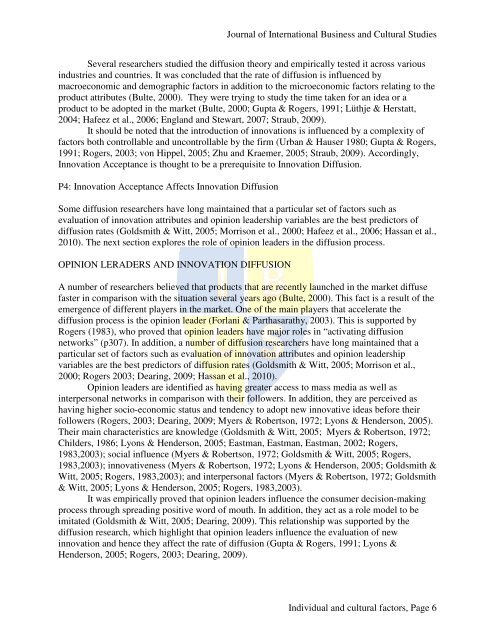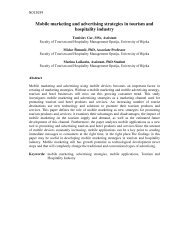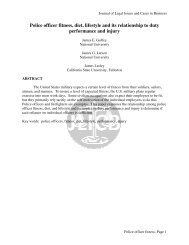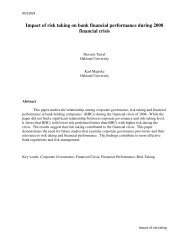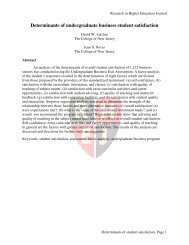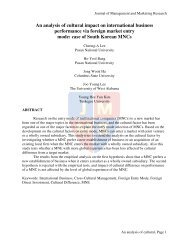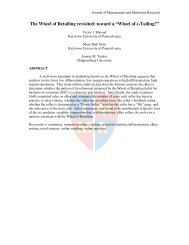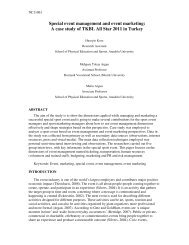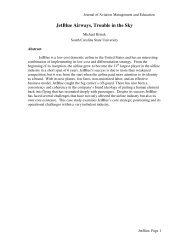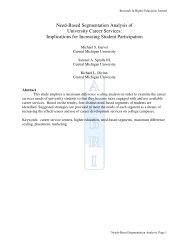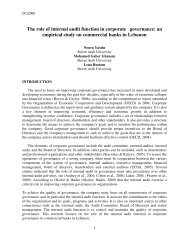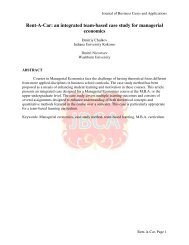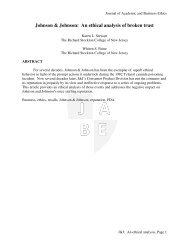Individual and cultural factors affecting diffusion of innovation
Individual and cultural factors affecting diffusion of innovation
Individual and cultural factors affecting diffusion of innovation
Create successful ePaper yourself
Turn your PDF publications into a flip-book with our unique Google optimized e-Paper software.
Journal <strong>of</strong> International Business <strong>and</strong> Cultural Studies<br />
Several researchers studied the <strong>diffusion</strong> theory <strong>and</strong> empirically tested it across various<br />
industries <strong>and</strong> countries. It was concluded that the rate <strong>of</strong> <strong>diffusion</strong> is influenced by<br />
macroeconomic <strong>and</strong> demographic <strong>factors</strong> in addition to the microeconomic <strong>factors</strong> relating to the<br />
product attributes (Bulte, 2000). They were trying to study the time taken for an idea or a<br />
product to be adopted in the market (Bulte, 2000; Gupta & Rogers, 1991; Lüthje & Herstatt,<br />
2004; Hafeez et al., 2006; Engl<strong>and</strong> <strong>and</strong> Stewart, 2007; Straub, 2009).<br />
It should be noted that the introduction <strong>of</strong> <strong>innovation</strong>s is influenced by a complexity <strong>of</strong><br />
<strong>factors</strong> both controllable <strong>and</strong> uncontrollable by the firm (Urban & Hauser 1980; Gupta & Rogers,<br />
1991; Rogers, 2003; von Hippel, 2005; Zhu <strong>and</strong> Kraemer, 2005; Straub, 2009). Accordingly,<br />
Innovation Acceptance is thought to be a prerequisite to Innovation Diffusion.<br />
P4: Innovation Acceptance Affects Innovation Diffusion<br />
Some <strong>diffusion</strong> researchers have long maintained that a particular set <strong>of</strong> <strong>factors</strong> such as<br />
evaluation <strong>of</strong> <strong>innovation</strong> attributes <strong>and</strong> opinion leadership variables are the best predictors <strong>of</strong><br />
<strong>diffusion</strong> rates (Goldsmith & Witt, 2005; Morrison et al., 2000; Hafeez et al., 2006; Hassan et al.,<br />
2010). The next section explores the role <strong>of</strong> opinion leaders in the <strong>diffusion</strong> process.<br />
OPINION LERADERS AND INNOVATION DIFFUSION<br />
A number <strong>of</strong> researchers believed that products that are recently launched in the market diffuse<br />
faster in comparison with the situation several years ago (Bulte, 2000). This fact is a result <strong>of</strong> the<br />
emergence <strong>of</strong> different players in the market. One <strong>of</strong> the main players that accelerate the<br />
<strong>diffusion</strong> process is the opinion leader (Forlani & Parthasarathy, 2003). This is supported by<br />
Rogers (1983), who proved that opinion leaders have major roles in “activating <strong>diffusion</strong><br />
networks” (p307). In addition, a number <strong>of</strong> <strong>diffusion</strong> researchers have long maintained that a<br />
particular set <strong>of</strong> <strong>factors</strong> such as evaluation <strong>of</strong> <strong>innovation</strong> attributes <strong>and</strong> opinion leadership<br />
variables are the best predictors <strong>of</strong> <strong>diffusion</strong> rates (Goldsmith & Witt, 2005; Morrison et al.,<br />
2000; Rogers 2003; Dearing, 2009; Hassan et al., 2010).<br />
Opinion leaders are identified as having greater access to mass media as well as<br />
interpersonal networks in comparison with their followers. In addition, they are perceived as<br />
having higher socio-economic status <strong>and</strong> tendency to adopt new innovative ideas before their<br />
followers (Rogers, 2003; Dearing, 2009; Myers & Robertson, 1972; Lyons & Henderson, 2005).<br />
Their main characteristics are knowledge (Goldsmith & Witt, 2005; Myers & Robertson, 1972;<br />
Childers, 1986; Lyons & Henderson, 2005; Eastman, Eastman, Eastman, 2002; Rogers,<br />
1983,2003); social influence (Myers & Robertson, 1972; Goldsmith & Witt, 2005; Rogers,<br />
1983,2003); innovativeness (Myers & Robertson, 1972; Lyons & Henderson, 2005; Goldsmith &<br />
Witt, 2005; Rogers, 1983,2003); <strong>and</strong> interpersonal <strong>factors</strong> (Myers & Robertson, 1972; Goldsmith<br />
& Witt, 2005; Lyons & Henderson, 2005; Rogers, 1983,2003).<br />
It was empirically proved that opinion leaders influence the consumer decision-making<br />
process through spreading positive word <strong>of</strong> mouth. In addition, they act as a role model to be<br />
imitated (Goldsmith & Witt, 2005; Dearing, 2009). This relationship was supported by the<br />
<strong>diffusion</strong> research, which highlight that opinion leaders influence the evaluation <strong>of</strong> new<br />
<strong>innovation</strong> <strong>and</strong> hence they affect the rate <strong>of</strong> <strong>diffusion</strong> (Gupta & Rogers, 1991; Lyons &<br />
Henderson, 2005; Rogers, 2003; Dearing, 2009).<br />
<strong>Individual</strong> <strong>and</strong> <strong>cultural</strong> <strong>factors</strong>, Page 6


